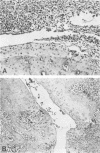Abstract
To investigate arthritis-inducing properties of Eubacterium species, which are major residents of the human intestinal flora, cell wall fragments (CWF) of several Eubacterium strains were prepared and tested in an animal model. After a single intraperitoneal injection in the rat, CWF of E. aerofaciens, E. contortum, and E. lentum induced a chronic polyarthritis. E. limosum and E. tortuosum CWF induced an acute self-limiting joint inflammation, whereas E. rectale CWF failed to do so. The rhamnose contents of the isolated CWF were not related to their arthritis-inducing properties. Paradoxically, the sensitivity of CWF to lysozyme digestion, which is regarded as a parameter for the clearance of CWF in tissues, appeared to be positively correlated with the ability of Eubacterium CWF to induce chronic joint inflammation. Our findings show the diversity in arthritis-inducing properties among different species of the anaerobic genus Eubacterium and underline the importance of the anaerobic intestinal flora in the induction of joint inflammation.
Full text
PDF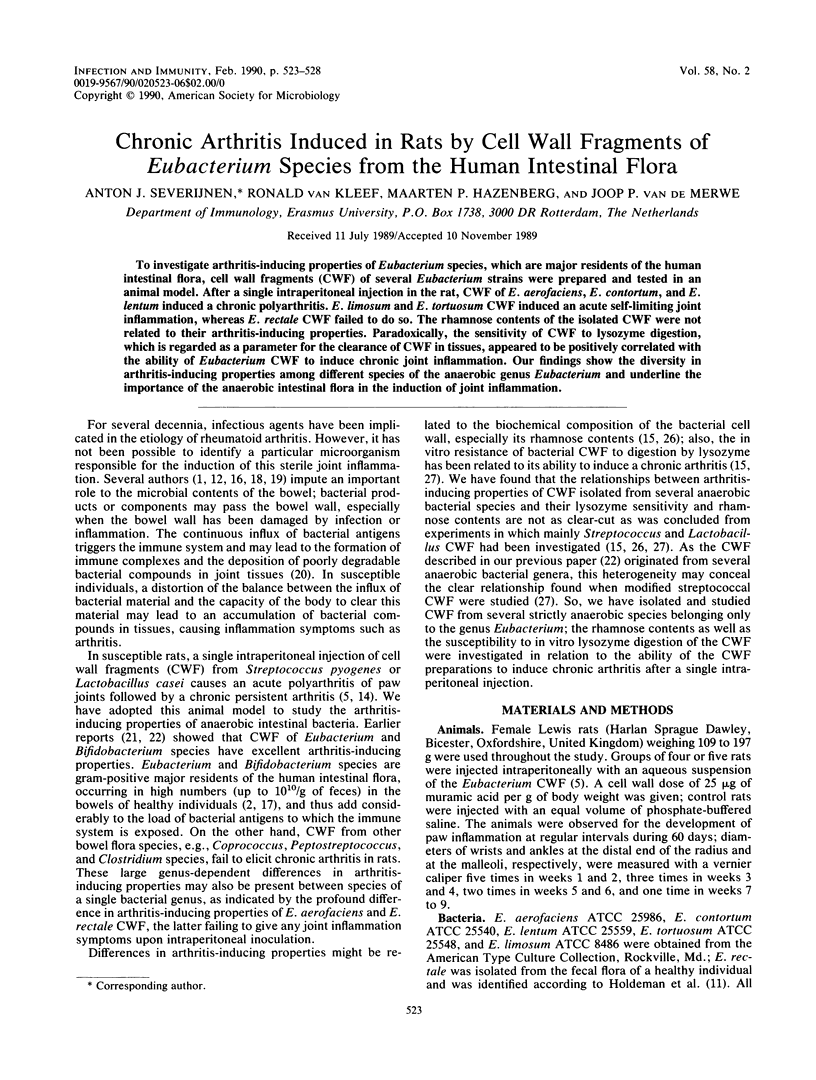
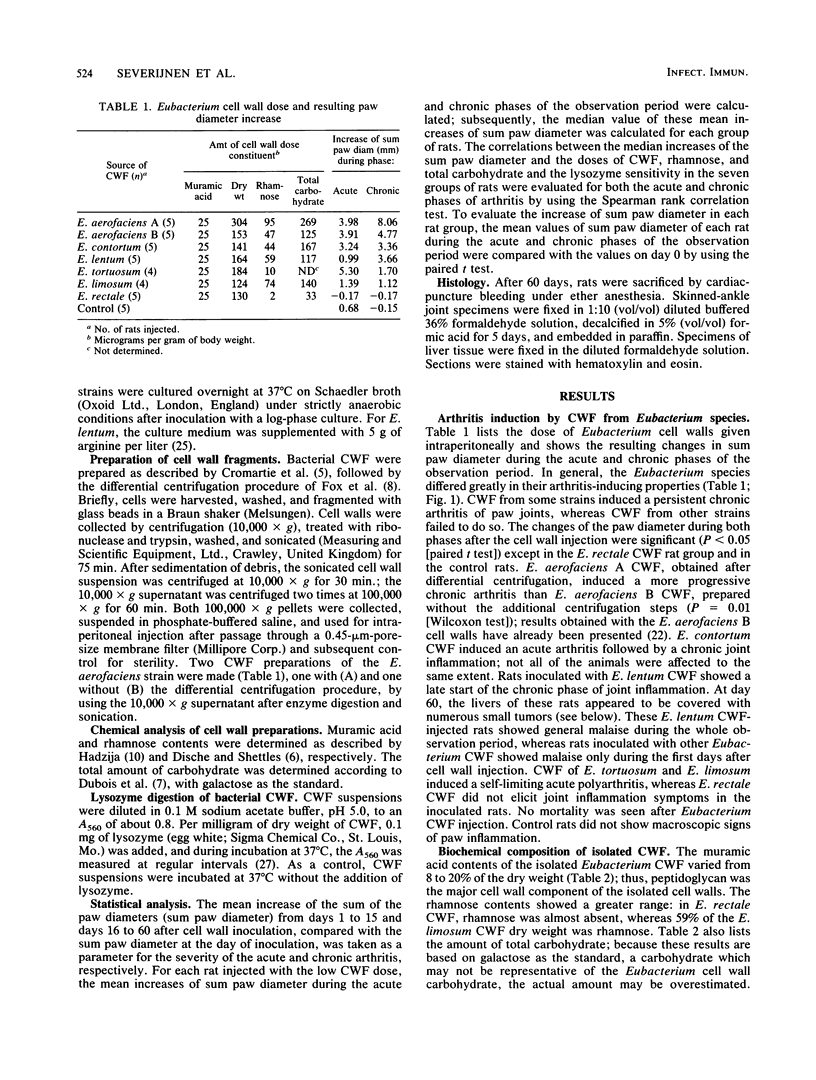
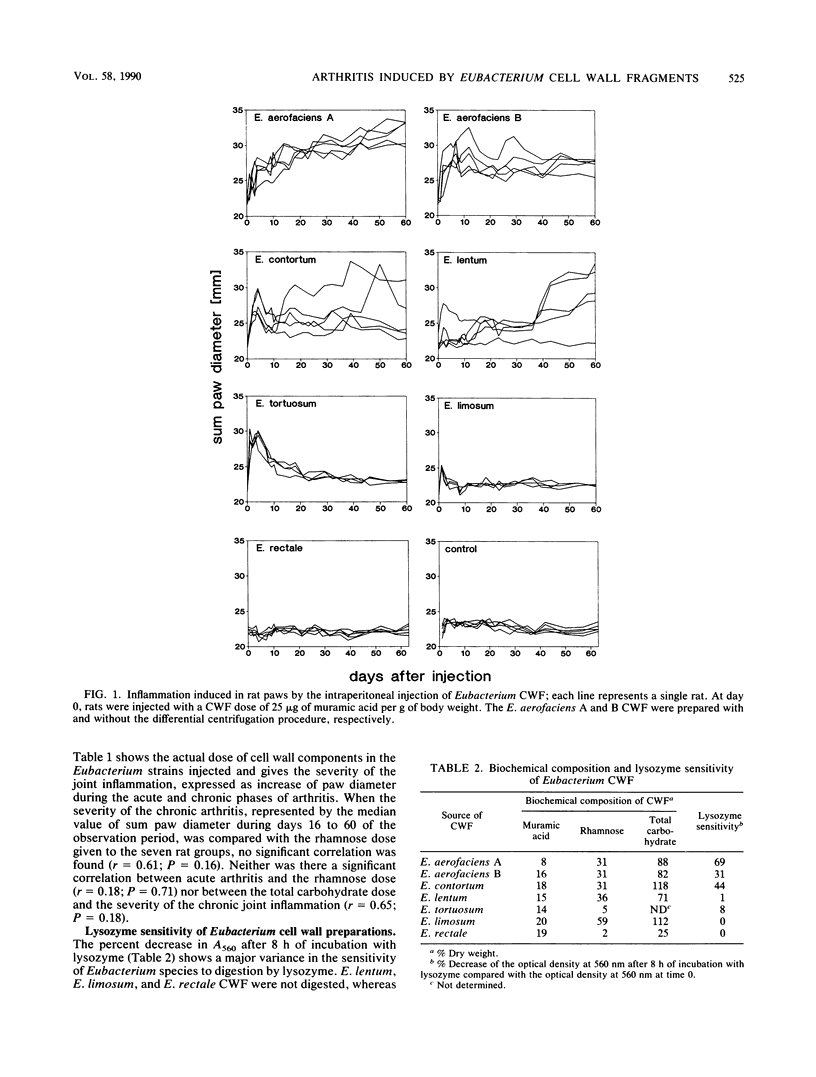
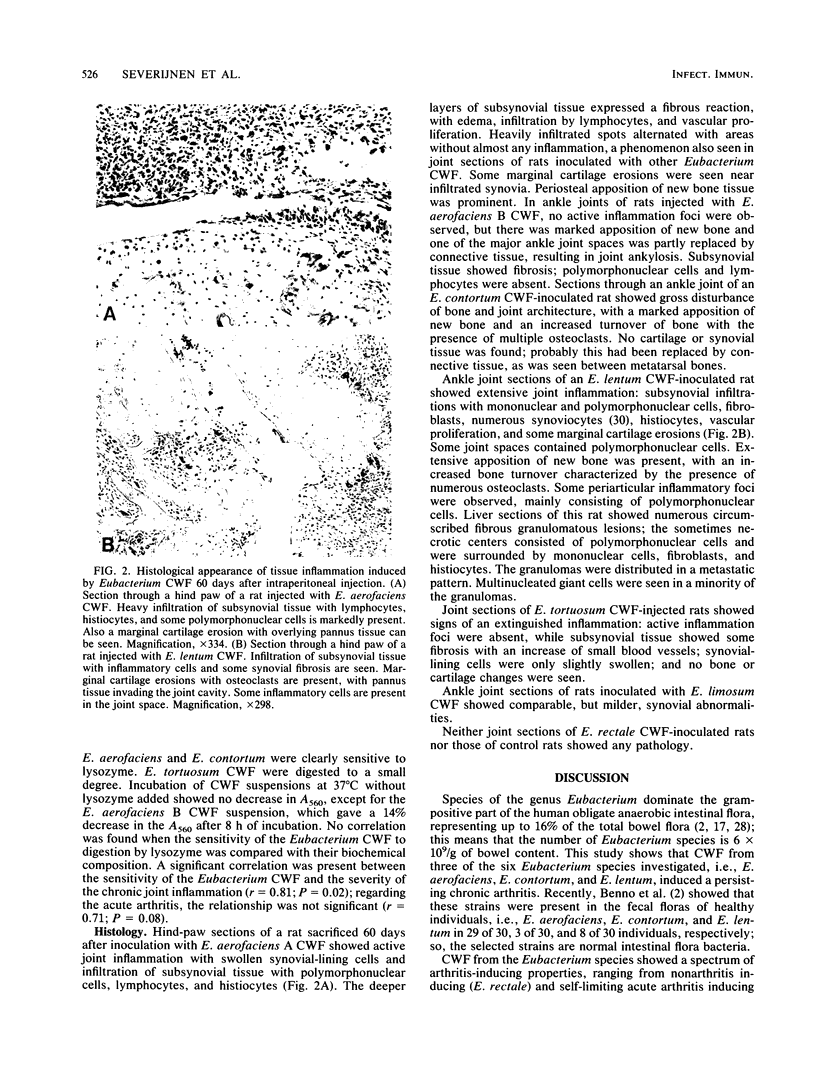
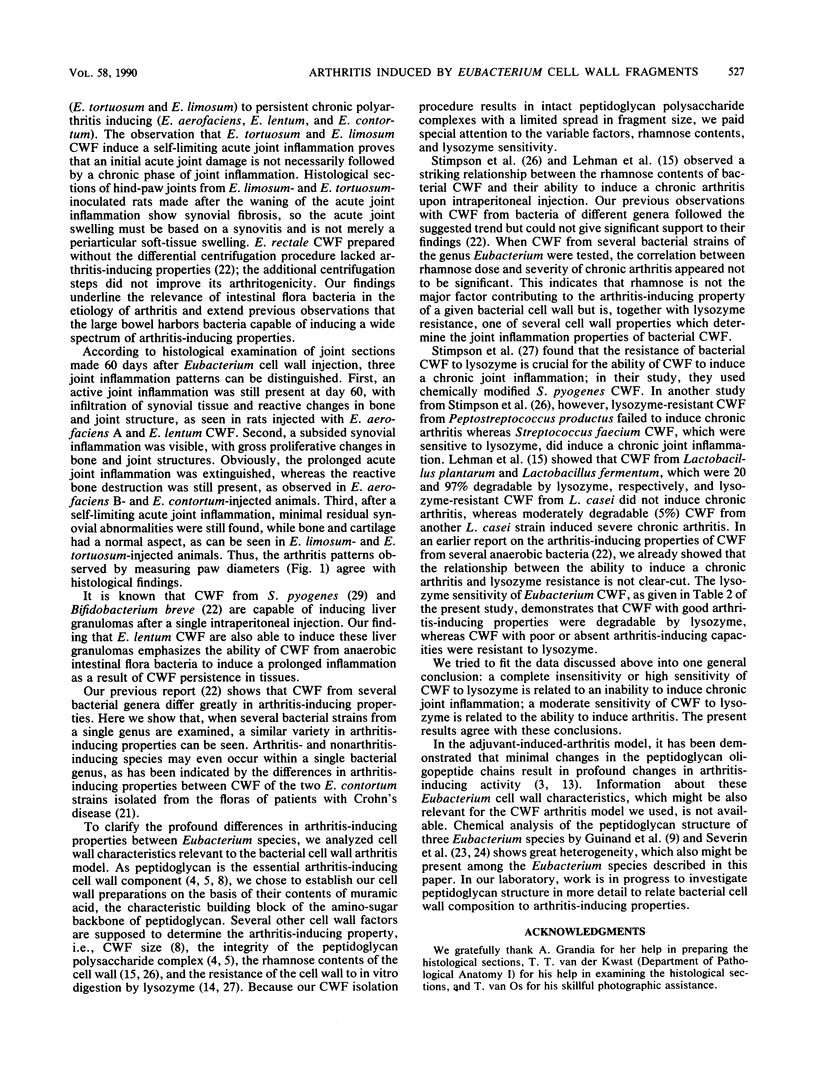
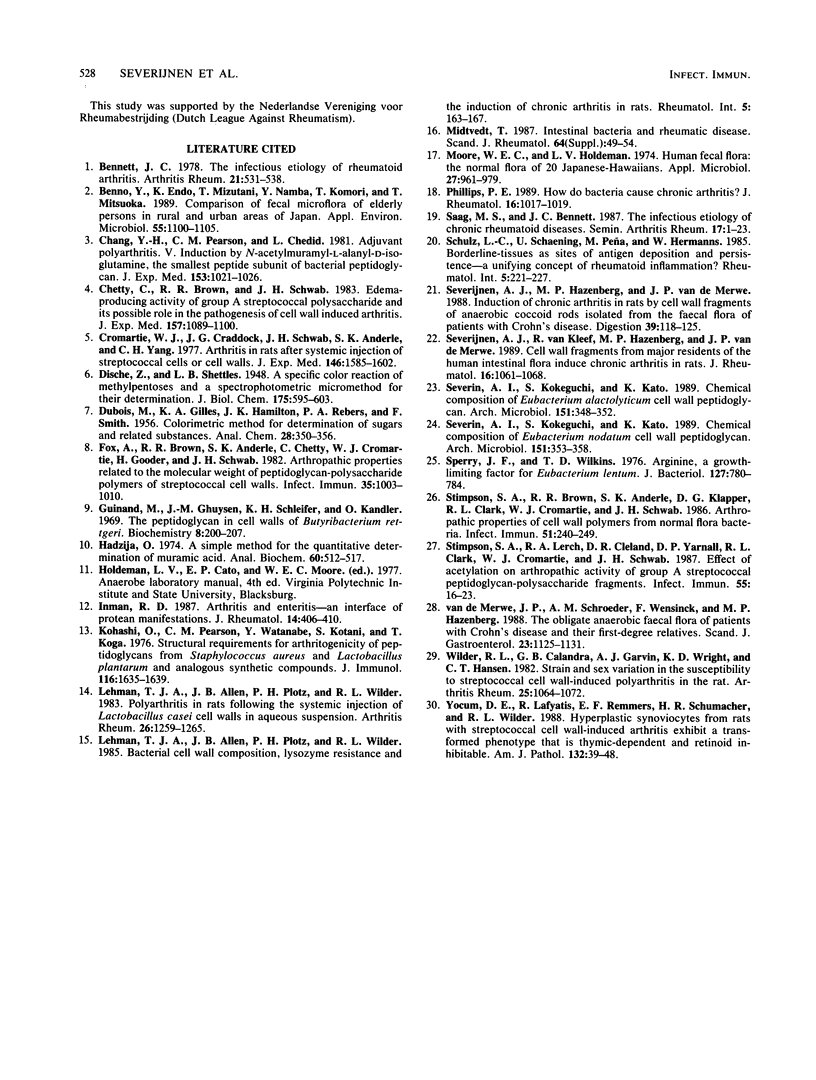
Images in this article
Selected References
These references are in PubMed. This may not be the complete list of references from this article.
- Bennett J. C. The infectious etiology of rheumatoid arthritis. New considerations. Arthritis Rheum. 1978 Jun;21(5):531–538. doi: 10.1002/art.1780210507. [DOI] [PubMed] [Google Scholar]
- Benno Y., Endo K., Mizutani T., Namba Y., Komori T., Mitsuoka T. Comparison of fecal microflora of elderly persons in rural and urban areas of Japan. Appl Environ Microbiol. 1989 May;55(5):1100–1105. doi: 10.1128/aem.55.5.1100-1105.1989. [DOI] [PMC free article] [PubMed] [Google Scholar]
- Chang Y. H., Pearson C. M., Chedid L. Adjuvant polyarthritis. V. Induction by N-acetylmuramyl-L-alanyl-D-isoglutamine, the smallest peptide subunit of bacterial peptidoglycan. J Exp Med. 1981 Apr 1;153(4):1021–1026. doi: 10.1084/jem.153.4.1021. [DOI] [PMC free article] [PubMed] [Google Scholar]
- Chetty C., Brown R. R., Schwab J. H. Edema-producing activity of group A streptococcal polysaccharide and its possible role in the pathogenesis of cell wall-induced polyarthritis. J Exp Med. 1983 Apr 1;157(4):1089–1100. doi: 10.1084/jem.157.4.1089. [DOI] [PMC free article] [PubMed] [Google Scholar]
- Cromartie W. J., Craddock J. G., Schwab J. H., Anderle S. K., Yang C. H. Arthritis in rats after systemic injection of streptococcal cells or cell walls. J Exp Med. 1977 Dec 1;146(6):1585–1602. doi: 10.1084/jem.146.6.1585. [DOI] [PMC free article] [PubMed] [Google Scholar]
- Fox A., Brown R. R., Anderle S. K., Chetty C., Cromartie W. J., Gooder H., Schwab J. H. Arthropathic properties related to the molecular weight of peptidoglycan-polysaccharide polymers of streptococcal cell walls. Infect Immun. 1982 Mar;35(3):1003–1010. doi: 10.1128/iai.35.3.1003-1010.1982. [DOI] [PMC free article] [PubMed] [Google Scholar]
- Guinand M., Ghuysen J. M., Schleifer K. H., Kandler O. The peptidoglycan in walls of Butyribacterium rettgeri. Biochemistry. 1969 Jan;8(1):200–207. doi: 10.1021/bi00829a029. [DOI] [PubMed] [Google Scholar]
- Hadzija O. A simple method for the quantitative determination of muramic acid. Anal Biochem. 1974 Aug;60(2):512–517. doi: 10.1016/0003-2697(74)90261-9. [DOI] [PubMed] [Google Scholar]
- Inman R. D. Arthritis and enteritis--an interface of protean manifestations. J Rheumatol. 1987 Jun;14(3):406–410. [PubMed] [Google Scholar]
- Kohashi O., Pearson C. M., Watanabe Y., Kotani S., Koga T. Structural requirements for arthritogenicity of peptidoglycans from Staphylococcus aureus and Lactobacillus plant arum and analogous synthetic compounds. J Immunol. 1976 Jun;116(6):1635–1639. [PubMed] [Google Scholar]
- Lehman T. J., Allen J. B., Plotz P. H., Wilder R. L. Bacterial cell wall composition, lysozyme resistance, and the induction of chronic arthritis in rats. Rheumatol Int. 1985;5(4):163–167. doi: 10.1007/BF00541517. [DOI] [PubMed] [Google Scholar]
- Lehman T. J., Allen J. B., Plotz P. H., Wilder R. L. Polyarthritis in rats following the systemic injection of Lactobacillus casei cell walls in aqueous suspension. Arthritis Rheum. 1983 Oct;26(10):1259–1265. doi: 10.1002/art.1780261013. [DOI] [PubMed] [Google Scholar]
- Midtvedt T. Intestinal bacteria and rheumatic disease. Scand J Rheumatol Suppl. 1987;64:49–54. doi: 10.3109/03009748709096721. [DOI] [PubMed] [Google Scholar]
- Moore W. E., Holdeman L. V. Human fecal flora: the normal flora of 20 Japanese-Hawaiians. Appl Microbiol. 1974 May;27(5):961–979. doi: 10.1128/am.27.5.961-979.1974. [DOI] [PMC free article] [PubMed] [Google Scholar]
- Phillips P. E. How do bacteria cause chronic arthritis? J Rheumatol. 1989 Aug;16(8):1017–1019. [PubMed] [Google Scholar]
- Saag M. S., Bennett J. C. The infectious etiology of chronic rheumatic diseases. Semin Arthritis Rheum. 1987 Aug;17(1):1–23. doi: 10.1016/0049-0172(87)90013-8. [DOI] [PubMed] [Google Scholar]
- Schulz L. C., Schaening U., Peña M., Hermanns W. Borderline-tissues as sites of antigen deposition and persistence--a unifying concept of rheumatoid inflammation? Rheumatol Int. 1985;5(5):221–227. doi: 10.1007/BF00541340. [DOI] [PubMed] [Google Scholar]
- Severijnen A. J., Hazenberg M. P., van de Merwe J. P. Induction of chronic arthritis in rats by cell wall fragments of anaerobic coccoid rods isolated from the faecal flora of patients with Crohn's disease. Digestion. 1988;39(2):118–125. doi: 10.1159/000199614. [DOI] [PubMed] [Google Scholar]
- Severijnen A. J., van Kleef R., Hazenberg M. P., van de Merwe J. P. Cell wall fragments from major residents of the human intestinal flora induce chronic arthritis in rats. J Rheumatol. 1989 Aug;16(8):1061–1068. [PubMed] [Google Scholar]
- Severin A. I., Kokeguchi S., Kato K. Chemical composition of Eubacterium alactolyticum cell wall peptidoglycan. Arch Microbiol. 1989;151(4):348–352. doi: 10.1007/BF00406563. [DOI] [PubMed] [Google Scholar]
- Severin A. I., Kokeguchi S., Kato K. Chemical composition of Eubacterium nodatum cell wall peptidoglycan. Arch Microbiol. 1989;151(4):353–358. doi: 10.1007/BF00406564. [DOI] [PubMed] [Google Scholar]
- Sperry J. F., Wilkins T. D. Arginine, a growth-limiting factor for Eubacterium lentum. J Bacteriol. 1976 Aug;127(2):780–784. doi: 10.1128/jb.127.2.780-784.1976. [DOI] [PMC free article] [PubMed] [Google Scholar]
- Stimpson S. A., Brown R. R., Anderle S. K., Klapper D. G., Clark R. L., Cromartie W. J., Schwab J. H. Arthropathic properties of cell wall polymers from normal flora bacteria. Infect Immun. 1986 Jan;51(1):240–249. doi: 10.1128/iai.51.1.240-249.1986. [DOI] [PMC free article] [PubMed] [Google Scholar]
- Stimpson S. A., Lerch R. A., Cleland D. R., Yarnall D. P., Clark R. L., Cromartie W. J., Schwab J. H. Effect of acetylation on arthropathic activity of group A streptococcal peptidoglycan-polysaccharide fragments. Infect Immun. 1987 Jan;55(1):16–23. doi: 10.1128/iai.55.1.16-23.1987. [DOI] [PMC free article] [PubMed] [Google Scholar]
- Van de Merwe J. P., Schröder A. M., Wensinck F., Hazenberg M. P. The obligate anaerobic faecal flora of patients with Crohn's disease and their first-degree relatives. Scand J Gastroenterol. 1988 Nov;23(9):1125–1131. doi: 10.3109/00365528809090179. [DOI] [PubMed] [Google Scholar]
- Wilder R. L., Calandra G. B., Garvin A. J., Wright K. D., Hansen C. T. Strain and sex variation in the susceptibility to streptococcal cell wall-induced polyarthritis in the rat. Arthritis Rheum. 1982 Sep;25(9):1064–1072. doi: 10.1002/art.1780250906. [DOI] [PubMed] [Google Scholar]
- Yocum D. E., Lafyatis R., Remmers E. F., Schumacher H. R., Wilder R. L. Hyperplastic synoviocytes from rats with streptococcal cell wall-induced arthritis exhibit a transformed phenotype that is thymic-dependent and retinoid inhibitable. Am J Pathol. 1988 Jul;132(1):38–48. [PMC free article] [PubMed] [Google Scholar]



